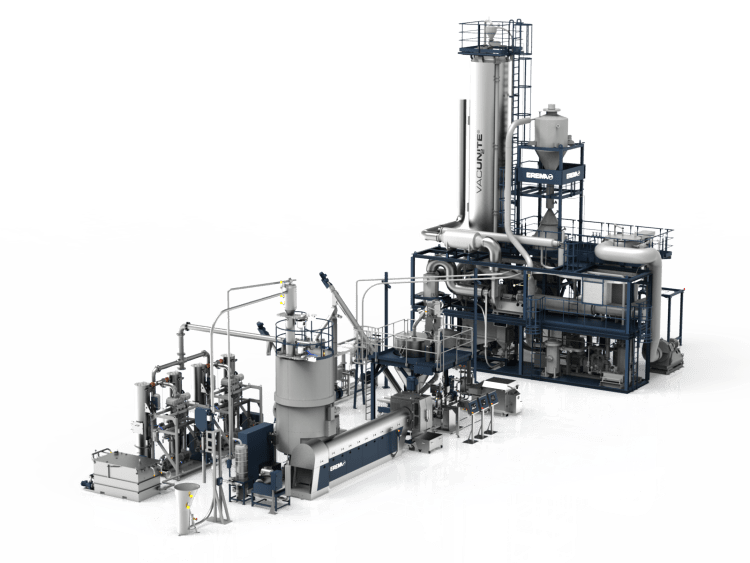
When it comes to the efficient and safe processing of PET waste, Erema can draw on valuable experience. The bottle systems made by the Austrian recycling machine manufacturer have 25 years of proven experience on the market. Almost half of the bottle systems shipped in the past three years have been installed in Asia. The production of food contact compliant rPET is becoming increasingly important there - also in the textile industry. Erema impresses with the highest quality standards and not only easily undercuts the strict limit values of the European and North American authorities for food safety recognised worldwide, but also meets the specifications of global brands. At Chinaplas in Shanghai from 23 to 26 April, 2024, Erema experts will be on hand to share their expertise with trade fair visitors interested in recycling.
The ongoing growth of the PET industry, especially in Asia and Africa, is boosting the demand for recycling solutions for PET waste. "We offer the right systems for specific requirements, including for direct food contact," says James Qiu, General Manager at Erema Shanghai. The central element is the tried-and-tested Vacurema technology, which the international machine manufacturer launched 25 years ago and has been continuously developing ever since. Over 400 PET systems for food grade are in operation worldwide using various technologies such as Vacurema Basic, Advanced, Prime, MPR, and Vacunite, notching up a total capacity of more than four million tonnes per year. In the last three years alone, Erema has delivered 100 systems for the bottle market. Almost 60 percent of these are bottle-to-bottle solutions. The rest are divided between bottle-to-sheet, PET strapping and the bottle-to-fibre segment, which is going from strength to strength.
Decontamination already prior to extrusion
Reliable recycling performance is needed to produce food-safe, visually flawless rPET pellets from starting materials of widely varying quality. The main advantage of Vacurema machines is the SafeFlake technology in the vacuum reactor, which brings together decontamination, drying and IV treatment. Thanks to the pretreatment of the PET flakes in vacuum at the correct temperature, moisture and migration substances are effectively removed already prior to extrusion. This prevents any hydrolytic and oxidative decomposition of the melt in the extruder. The quality of the rPET pellets remains consistently high even if the parameters of the input material - such as moisture, mixture or bulk density - vary.
In addition to the quality aspects, the financial factors are also a strong argument in favour of this recycling process. This is because both the total costs of acquisition and use (total costs of ownership) and the energy consumption are comparatively low. "The specific overall energy consumption of a Vacurema Prime system is only 0.295 kWh/kg, for example. This is a top energy efficiency value compared to conventional PET processing lines on the market," says Christoph Wöss, Business Development Manager for the Bottle segment at Erema. Vacurema Prime is a version of the process where two crystallisation dryers immediately upstream from the vacuum reactor operate in batch mode alternately - also in vacuum - to decontaminate the material. The intrinsic viscosity (IV) is increased thanks to Solid State Polycondensation (SSP) on the flake.
Double safety with Vacunite
Legal requirements and the much publicised commitment of well-known brand owners are pointing the way towards a big increase in the proportion of recyclate used in products such as PET bottles. "Recycling machines have to produce better quality output material despite the decreasing quality of the input material," explains Christoph Wöss. "That is where Vacunite comes in, to meet these requirements." Together with Polymetrix, Erema has developed the tried-and-tested Vacurema process to include vacuum-assisted SSP in a nitrogen atmosphere. All of the thermal process steps are performed in nitrogen and/or vacuum.
Decontamination carried out at the beginning and end of the processing sequence means double safety for users. "With Vacunite we offer our bottle-to-bottle customers a new technology which sets new standards at all levels from technical performance to recyclate quality," says Christoph Wöss. The nitrogen used in the SSP is purified and can be fed back into the processing stage upstream so that nitrogen consumption is reduced as a result. Another advantage of Vacunite is the improved colour values. "We can retain the transparency of the material even after several recycling cycles, which makes bottle-to-bottle recycling fit for the future - for a truly functional circular economy," says Christoph Wöss.

Vacunite systems see Erema combine proven Vacurema technology with the vacuum-assisted nitrogen SSP from Polymetrix.



